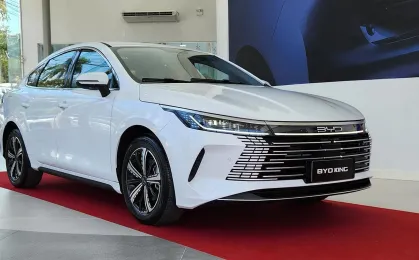In the rapidly evolving world of electric vehicles (EVs), BYD’s new Blade Battery is making waves as a potential game changer. As the demand for sustainable mobility solutions surges, innovations like these are critical to advancing the EV industry. According to Bloomberg Green, the global electric vehicle market is projected to grow at a compound annual growth rate of 21.7% from 2020 to 2027. With such promising growth, BYD’s introduction of the Blade Battery could be a pivotal moment not just for the brand, but for the entire EV ecosystem. In this article, we will explore what makes the Blade Battery revolutionary, its impact on the EV market, and how it could influence your next vehicle purchase.
Understanding the Blade Battery Technology
What is the Blade Battery?
The Blade Battery, developed by BYD, stands out due to its unique design and technological advancements. Unlike traditional lithium-ion batteries, the Blade Battery uses lithium iron phosphate (LFP) chemistry, which is known for its safety and sustainability. This battery’s design features long, thin cells that resemble blades, hence the name. This configuration allows for better space utilization within the battery pack, significantly increasing energy density and efficiency.
- Safety First: One of the most significant advantages of the Blade Battery is its safety. According to InsideEVs, the Blade Battery passed the rigorous nail penetration test, a critical safety measure for batteries, without any signs of fire or smoke. This is a noteworthy improvement over conventional lithium-ion batteries, which can be prone to thermal runaway.
- Longer Lifespan: BYD claims that the Blade Battery can last up to 1.2 million kilometers (approximately 746,000 miles) or over 3,000 charge cycles. This durability is crucial for reducing long-term ownership costs and enhancing vehicle longevity.
Enhanced Performance and Efficiency
Performance is key in the competitive EV market, and the Blade Battery does not disappoint. With a higher energy density, it allows vehicles to achieve greater range without increasing battery size or weight. This is essential for urban commuters who require efficient and reliable transportation.
- Improved Range: According to AutoCar, vehicles equipped with Blade Batteries can achieve ranges comparable to those with traditional lithium-ion packs, but with improved safety and cost-effectiveness.
- Faster Charging: While the Blade Battery excels in safety and longevity, it also supports faster charging times. This feature addresses one of the primary concerns of EV owners and potential buyers who worry about lengthy charging sessions.
Impact on the Electric Vehicle Market
Shaping Future EV Designs
BYD’s Blade Battery is not just a technological marvel but also a catalyst for future EV designs. As manufacturers strive to offer safer and more efficient vehicles, the Blade Battery’s attributes could set new industry standards.
- Cost-Effective Manufacturing: The use of LFP chemistry in Blade Batteries is less expensive than cobalt-based batteries, which could lead to cost savings for manufacturers and, ultimately, consumers.
- Scalability: The compact design of the Blade Battery allows for modular scalability, making it an attractive option for various vehicle types, from compact cars to larger SUVs.
Competition and Market Dynamics
The introduction of the Blade Battery is likely to influence competitive dynamics in the EV market. Brands like Tesla, Hyundai, and Volkswagen may need to reevaluate their battery technologies to keep pace with BYD’s advancements. According to Reuters Mobility, the race for better battery technology is heating up, and BYD is positioning itself as a formidable player.
Practical Implications for EV Buyers
How to Choose the Right EV
When considering an electric vehicle, battery technology is a crucial factor. Here’s what you should consider:
- Safety: Look for vehicles with advanced safety features, including battery technologies like the Blade Battery that prioritize safety.
- Range: Evaluate your daily driving needs and select a vehicle with a sufficient range to meet them.
- Cost: Consider not just the upfront cost but also long-term savings from reduced maintenance and fuel expenses.
Where to Buy and What to Compare
If you’re interested in a vehicle equipped with a Blade Battery, keep an eye on BYD’s upcoming models and announcements. Here’s a quick comparison list to consider:
- BYD Han EV: Known for its impressive range and luxurious features.
- Tesla Model 3: A popular choice with a robust charging network.
- Hyundai Kona Electric: Offers a blend of efficiency and affordability.
Conclusion: The Future of EVs with Blade Battery Technology
BYD’s Blade Battery is more than just a technological innovation; it represents a significant step forward in the quest for safer, more efficient, and environmentally friendly transportation. As the electric vehicle market continues to expand, the Blade Battery’s influence is likely to grow, prompting other manufacturers to innovate and improve their offerings.
Are you considering an electric vehicle? Explore models equipped with advanced battery technologies like the Blade Battery that prioritize safety, performance, and sustainability. As we look to the future, advancements like these will shape the landscape of urban transport, making sustainable mobility a reality for everyone.
In conclusion, the Blade Battery is not just a game changer for BYD but a potential catalyst for the entire industry. As we continue to embrace sustainable mobility solutions, innovations like these will pave the way for a cleaner, more efficient future. What are your thoughts on the new Blade Battery? Could this be the solution the EV market has been waiting for? Share your opinions and join the conversation about the future of electric vehicles.

